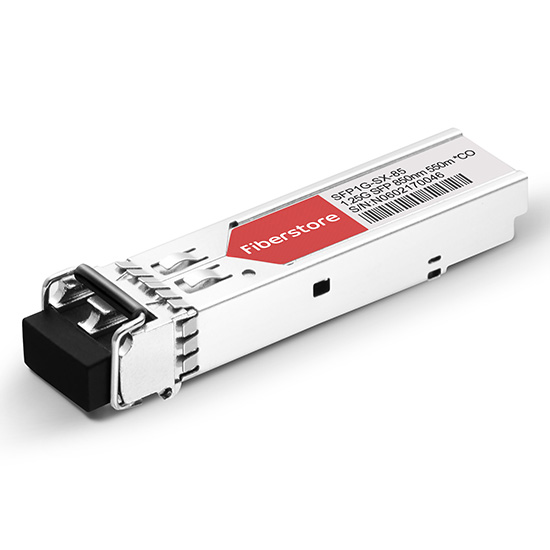Cisco 1000BASE SFPs keep a huge market share in the optic area. Cisco SFPs offer users optical solutions for long distance and short distance transmission. For short distance, there are 1000BASE SX SFP, such as Cisco GLC-SX-MM and Cisco GLC-SX-MMD. Though these two modules have great similarity, they are actually different. Then what’s the difference? This article will introduce the details of Cisco GLC-SX-MM and Cisco GLC-SX-MMD SFP transceiver modules.

Cisco GLC-SX-MM
Cisco GLC-SX-MM 1000BASE-SX SFP is a duplex transceiver for short distance transmission, operating at the wavelength of 850 nm at the data rate of 1Gbps. It connects with OM2 multimode LC patch cords supporting up to 550 meters. The hot-swappable 1000BASE-SX SFP is compatible with the IEEE 802.3z 1000BASE-SX standard. And it’s RoHS compliant.
Cisco GLC-SX-MMD
Cisco GLC-SX-MMD 1000BASE-SX SFP is another type of hot-swappable optical transceiver for short reach data transmission. This 1000Base-SX transceiver supports data rates up to 1.25Gbps. Same to Cisco GLC-SX-MM SFP, it also has duplex LC interference. Connecting with OM2 MMF, it can support the distance up to 550 meters. It’s compliant with SFP Multi-Source Agreement (MSA) standards. Cisco GLC-SX-MMD is composed of five parts: the LD driver, the limiting amplifier, the digital diagnostic monitor, the VCSEL laser and the PIN photo-detector. The Digital Diagnostic Monitoring (DDM) function is its special feature.
DDM of GLC-SX-MMD
From the above content, you can see the main difference between these two transceivers is the DDM. When you buy SFP transceivers in the market, you may come across this selection difficulty whether to choose an SFP with DDM or not. So what’s DDM?
DDM is short for digital diagnostic monitoring. It’s also known as diagnostic optical monitoring (DOM). Diagnostic monitoring interface outlined in the SFF-8472 MSA is an extension of the serial ID interface defined in the GBIC specification, as well as in the SFP MSA. Today, many SFP transceivers have the function of digital diagnostics monitoring according to the industry standard MSA SFF-8472. It provides the important information about the status of the transmitted and received signals. This approach allows for better fault isolation and error detection.
DDM mainly plays the role in two sides: monitoring and warning. It monitors detailed information about a transceiver. And it offers a system of alarm and warning flags which alert the host system when particular operating parameters are not in line with the normal operating parameters set by the factory. So users can find out the fault isolation according to outcomes of DDM, and predict failure possibilities and prevent such fault.
Real-time monitoring—With a 2-wire serial bus (also known as “I2C” or “I2C” protocol), digital diagnostics can monitor the SFP module’s temperature, receiver power, transmitter bias current, and transmitter power by a microcontroller inside the transceiver. Usually, the output of the physical value of each parameter is an analog voltage or current from the Trans impedance amplifier, the laser driver, or the post amplifier. Then the digitalised value can be processed as part of a control loop, trigger an alarm, or just record the data into a register.
Calibration and warning thresholds—In addition to generating digital readings of internal analog values, DDM can also produce various status bits. Calibration and warning thresholds value is made during the device manufacturing process. Comparing current values generated by DDM and factory preset limits, users will know whether or not the transceivers have met the desired operation requirements.
FS.COM Cisco Compatible GLC-SX-MM SFPs
FS.COM brings Cisco compatible 1000BASE-SX SFPs including GLC-SX-MM and GLC-SX-MMD SFPs.
The 1000BASE-SX standard optics are developed to support lower cost multi-mode fibre runs in horizontal and shorter-length backbone applications. The following figure shows two Cisco GLC-SX-MM SFP transceivers are connected by an LC MMF patch cable.

| Item | Part No. | Description |
| a. | 11774 | Cisco GLC-SX-MM Compatible 1000BASE-SX SFP 850nm 550m Transceiver |
| b. | 43132 | 2M LC UPC to LC UPC Duplex 2.0mm PVC(OFNR) OM2 Fibre Optic Patch Cable |
| b. | 11774 | Cisco GLC-SX-MM Compatible 1000BASE-SX SFP 850nm 550m Transceiver |
Note: you can use GLC-SX-MMD SFPs to replace GLC-SX-MM SFPs for shorter-length backbone application, too.
Conclusion
This article introduces Cisco GLC-SX-MM and Cisco GLC-SX-MMD SFP transceivers. Both kinds can realise short distance connection. The difference is that GLC-SX-MMD has DDM function while the other has no. So it’s up to you to decide whether you need DDM function to monitor parameters of the SFP. Fiberstore supplies optical transceivers with DDM and without DDM to satisfy customers’ different needs. If you need more information, please contact us via sales@fs.com or visit our site www.fs.com/uk.
Related Article: A Quick Overview of Cisco 1000BASE-T GLC-T SFP Copper Module
